What Is A Solar RV TPMS?
Tire pressure monitoring systems are not new to most vehicle owners. A TPMS is a system of sensors that monitors tire pressure (PSI).
It’s a fantastic safety feature that most new vehicles have built in.
Travel trailers, 5th-wheels, and utility trailers don’t ordinarily come with a TPMS system, but it’s just as important to monitor the pressure in trailer and RV tires as it is for vehicle tires.
A solar RV TPMS or solar tire pressure monitoring system is sensors that connect to a small monitor that’s powered by a small built in solar panel.
Being solar powered makes the monitor super portable and easy to install almost anywhere inside your vehicle or RV.
See Also: Best 12V RV Air Compressor/Tire Inflator With Gauge
The GUTA solar tire pressure monitoring system for RVs and trailers comes in kits of 4, 6, and 8 sensors, depending on how many tires your RV, trailer, or vehicle have.
There’s also a signal repeater available for purchase for longer trailers and motorhomes.
In this review, I’ll go over the main features of the GUTA M20 TPMS and talk about my experience using it on a truck and utility trailer.
Guta M20 TPMS Overview
M20 Guta Solar RV TPMS
Main Features
- Range up to 36 feet.
- USB & Solar Monitor Charging
- 5 Alarms – Fast Leak, High/Low Pressure, High Temperature, Low Voltage, Sensor Disconnection
- Day/Night Screen Brightness
- Can display up to 8 sensors at a time.
- Anti-theft locking nut system.
- Monitor will display PSI, tire location, and temperature simultaneously.
- Spare Tire Monitoring
- Display Auto Off
- Optional Repeater Available
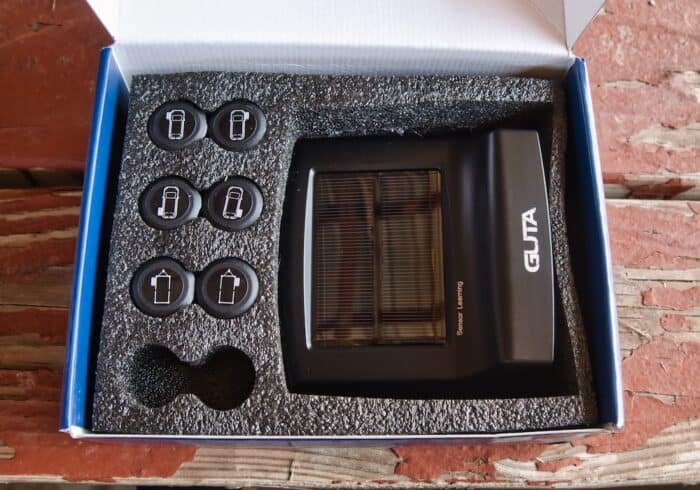
What’s in the Box?
- Guta Solar Monitor
- Tire Pressure Monitoring Sensors (4,6,8, single options available)
- USB Charging Cable
- Anti-Theft Locking Nuts & Wrench
- Anti-Slip Dash Pad
- Sensor Position Stickers
- User Manual
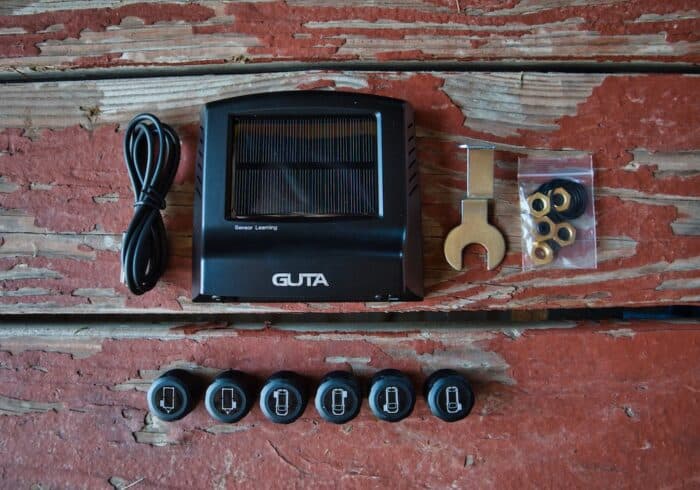
Guta Solar TPMS Installation
Even though it’s solar powered, Guta recommends fully charging the monitor with the included USB cable before using it for the first time.
While the monitor is charging make sure the tires on the RV, trailer, or vehicle you are installing the sensors on are at the right PSI.
Once the monitor is charged make sure it’s turned on before you place the sensors.
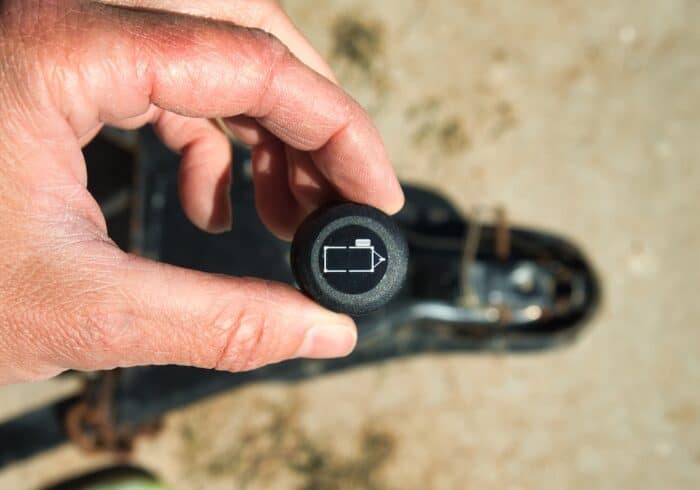
Before installing the sensors, use the included stickers to assign each TPMS sensor to a tire.
This will help in the future if you ever rotate tires or need to remove a sensor.
See Also: The 5 Things You Must Do When A Trailer Starts To Sway
Put an anti-theft hex nut on the stem first if you want to use that feature.
Make sure the nut is screwed in as far as it will go so it won’t stop the sensor from being fully installed on the stem.
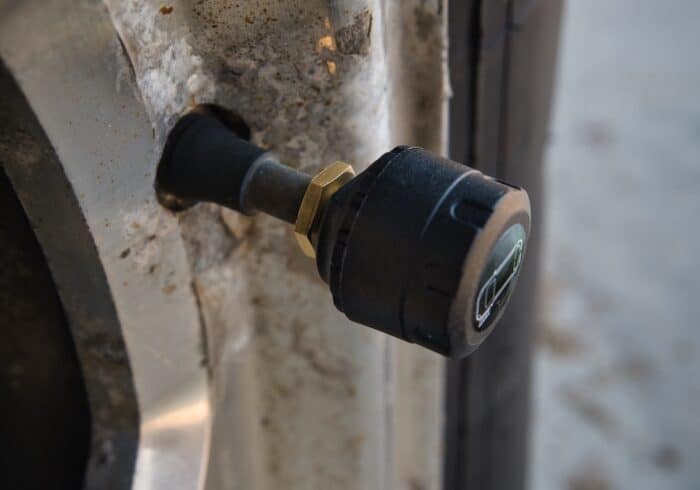
Screw on the sensor quickly, some air will be released but if you keep going it will stop leaking.
Once the sensor is fully installed use the included wrench to tighten the hex nut to the back of the sensor.
The hex nut makes it so you cannot remove the sensor without the special wrench.
If you ever lose the wrench, GUTA has a replacement kit available (click to view on Amazon).
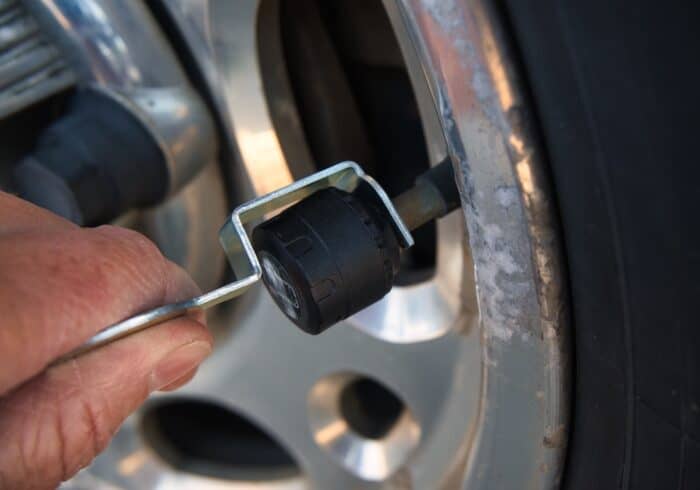
To remove the sensor with the anti-theft nuts installed, use the wrench to move the nut away from the sensor (turn it to the right).
Once the anti-theft nut is released from the back of the sensor, you will be able to unscrew it from the tire stem.
The sensors should connect automatically to the monitor if it was turned on before they were installed on the tires.
On the monitor, you can select each tire and change the units from Fahrenheit to Celsius.
When a tire is selected you can see the temperature for that specific tire.
See Also: Best Wireless RV Backup Cameras & Systems Reviewed
You can’t change the target tire pressure on the monitor. Whatever the tire pressure was when you installed the sensors is the now the base pressure.
If the pressure goes below 15% the original pressure, the low pressure alert will come on.
If it goes 25% above, the high pressure alert will come on.
It’s a super simple system that makes it very user friendly if you can easily adjust your tire pressure.
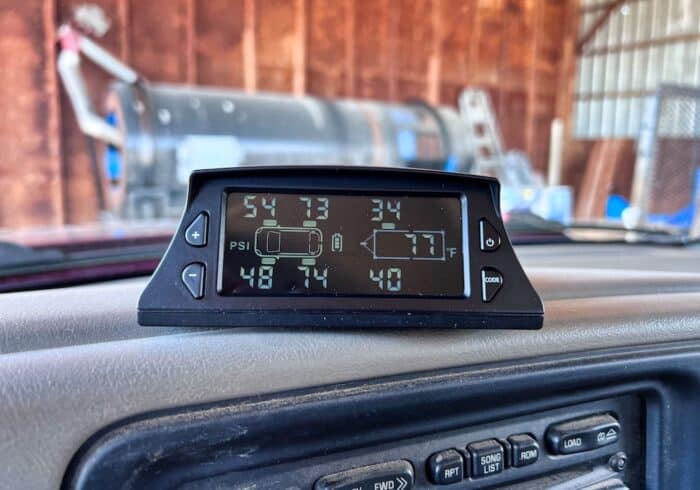
GUTA RV TPMS Review
I installed the GUTA on a truck and a small single axle utility trailer.
It’s mostly meant for RV use, but I wanted to test them on something I could drive around easily.
I’ll install them on my motorhome with 6 tires later, but for this test I wanted to see how well it could stay connected to a trailer.
In the picture above, you can see that the tire pressures were a little all over the place.
The front tires were supposed to be around 50 PSI, the back tires 75 PSI, and the trailer 35 PSI.
I had to do a little inflating and deflating after taking these photos.
I tested the tires with a gauge to make sure the GUTA TPMS was accurate.
It was 1 PSI off on a few tires, but overall, it was very accurate, according to the pressure gauge I was using.
See Also: Best RV 5th-Wheel & Travel Trailer Tires Review/Buying Guide
I drove around for a few hours and everything stayed connected to the monitor, even when going 65 mph.
One thing I’ll note is that since the range is only 35 feet, I recommend getting the repeater (click to view on Amazon) if you are going to use the GUTA TPMS with a truck and travel trailer or 5th-wheel.
You might get good readings at slow speeds, but once you’re on the highway, the sensors might disconnect or the signal will get spotty.
Overall, I’m happy with the performance of the M20 Guta Solar RV TPMS (click to view on Amazon).
It’s a great budget friendly option for vehicle, trailer, and RV owners that’s very easy to install and use.
It worked for me on a truck and small trailer, and I can’t wait to test it on my next camping trip on my motorhome.
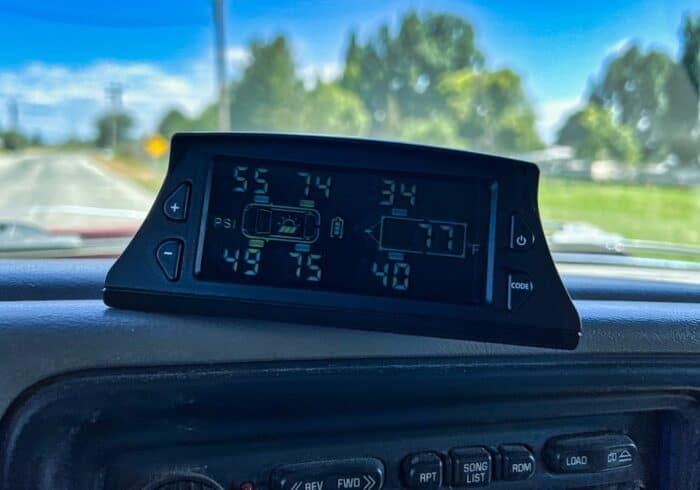
What I Like
- Easy to Set Up
- Accurate
- Comes with stickers to show where each sensor should go.
- Solar Powered
- Can also be USB powered using an included charging cable.
- Optional repeater for long trailers and motorhomes.
- Anti-Theft System
- Can replace the batteries in the sensors (extra O-rings are included for this).
What I Don’t Like
- Can’t change the target tire pressure on the monitor.
- Short range without the repeater.
Have questions about the GUTA solar RV tire pressure monitoring system? Leave a comment below.


